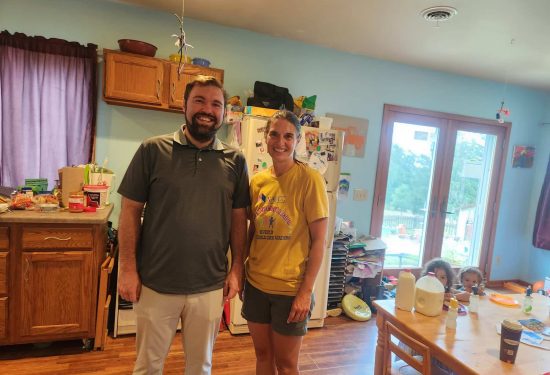This holiday season, we must make sure working families can find safe, affordable, accessible child care, and we need not look farther than our homes.
In-Home Child Care is Essential
With the CDC urging Americans to avoid travel for Thanksgiving and the looming uncertainty surrounding a rise in COVID-19 cases for the holiday season, the phrase “there’s no place like home for the holidays,” has taken on a decidedly different meaning.
Since March, our homes have become the epicenter of our worlds – our classroom, office, safety-zone – but for essential workers, life has changed in a different way. They still leave their homes to work at the jobs that have kept us all safe for the last several months. To help them do that, they needed their own essential workforce – one that stayed at home. They needed in-home child care providers.
It’s now November. Some states stayed open longer than others, and some have closed down and reopened more than once. With cases of COVID-19 surging throughout the United States, what has changed for those in-home providers? What has the last eight months taught us about what families need from the child care industry, and how can we address those needs?
Increased Demand for In-Home Child Care
Prior to the pandemic, many young children already received their early care and education at home, with nearly 7 million children spending their early education/child care experience in an in-home setting. For many parents, in-home care is not only the most affordable and accessible option, but the only option for care during nontraditional hours, like evenings and weekends, or for settings that share the same language or cultural practices that a child may experience at home and where siblings of different ages can be cared for together.
During the pandemic, the reliance on in-home child care increased. Unable to accommodate social distancing, the majority of child care centers, schools, and Head Start programs closed, while the majority of in-home child care providers remained open. Despite health and safety risks, these providers continued to welcome children into their homes. For many it was both to ensure families in their community had child care and out of financial necessity.
“It’s not about the business, it’s about the home. Some [providers] may lose their homes after this pandemic. Everything is not going back to normal – people don’t understand this part of the business.”
Pyrena Hui, In-Home Child Care Provider, San Francisco CA
In-Home Child Care Programs Are in Crisis
The pandemic destabilized the already fragile child care industry, and families and in-home providers have been largely left to fend for themselves. With centers closed, some in-home providers had a surge in attendance, and have had to turn families away. As unemployment increased and many parents began working from home, and with families periodically quarantining due to COVID-19 exposure, some providers experienced decreased enrollment, and had difficulty making ends meet without the expected tuition.
In short, we’ve encountered an unprecedented time of destabilization for the child care industry, one that has lasted far longer than anyone expected. In-home child care providers are being asked to do far more with inconsistent revenue, more supplies to purchase, and with great risk to themselves and their families. There is little support or guidance for their decisions to stay open or to close. Thinking ahead, we need to ask ourselves how do we prevent this from happening again? How did we let the child care industry become such a low priority in our country, when it’s a fundamental building block of our safety and economy?
“I’m taking this very seriously, it is me putting my life at risk to care for your children, and what you do will impact me, and all of the other children that are here.”
Lynn Barten, In-Home Child Care Provider, Alexandria MN
How to Support In-Home Child Care Providers?
To help in-home childcare providers survive this pandemic and ensure there are child care options available for all working families, we must invest in a child care infrastructure that assures quality and stability for children, families, and caregivers. While in-home caregivers are well-positioned to provide high-quality child care, many lack adequate compensation, health insurance, paid family and sick leave, and many other professional supports. Caregivers need access to professional development, educational materials and supplies, emotional support groups and business tools.
When in-home child care settings have adequate resources, parents do not have to choose between convenience and quality, or cultural match and affordability. When properly supported, families will have the infrastructure they need to survive a pandemic, and so will in-home child care providers.
In-home child care:
- Nurtures young children’s physical, cognitive, social and emotional development;
- Is located where near to where families live and work;
- Is provided by relatives or community members with multi-generational relationships with families;
- Shares families’ cultural, linguistic, and child-rearing practices, creating stability and affirming identity;
- Has the same caregiver providing consistent care to children over many years of a child’s life, often with siblings in the familiar, welcoming and supportive environment of the home.
“Childcare, especially home-based childcare, is so much more than babysitting. It’s not babysitting at all. It’s creating an environment of development and learning and love.”
Nancy Wyatt, In-Home Child Care Provider, San Fernando Valley CA
Safe, Affordable, & Accessible Child Care for Working Families
We must build a broad coalition of individuals and agencies to make children’s homes healthy and safe. We need to quickly ramp up our ability to equip caregivers to meet children’s developmental and learning needs. And we must ensure that this generation of children can thrive despite COVID-19 and the long term economic and social fallout it may leave in its wake.
As millions of Americans prepare for a long winter at the height of the pandemic, the key to turning the corner on COVID-19 lies in our homes. This holiday season, we may not be able to physically come together, but we can unite and support the providers caring for our children and helping American families get back to work. To do that, we must make sure working families can find safe, affordable, accessible child care, and we need not look farther than our homes.
References
- Recommendations for the Stabilization and Survival of the Essential Early Care and Education Sector | CSCCE
- Providing safe child care during COVID-19 — a life and death issue | The Hill
- The coronavirus might break the nuclear family. That wouldn’t be a bad thing. | The Washington Post
- Parents and the Changing Nature of Child Care | Bipartisan Policy Center
- We’ve Always Craved Being Home. Then We Were Told to Stay There | Philadelphia Magazine




